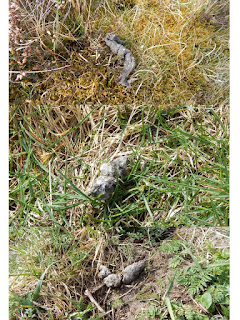 |
| Spot the Wood Mouse... |
This article contains links - these are not affiliate links and we are not sponsored by anyone!
After attending a small mammal trapping event recently I've grown to appreciate just how common the wood mouse (Apodemus sylvaticus) is. It is literally everywhere. And apparently, it loves hanging round people because we are messy so there is plenty of opportunity for food and shelter. So what's so special about the Wood Mouse?Wood Mice live in large social (family) groups in a burrow, and have a territory they defend from other social groups. They are highly adaptable to different living situations but as they preferably eat grains and seeds, they are mostly prevalent in agricultural settings, and are considered a serious agricultural pest species. Normal life span of a wild mouse is about 9 months, and they are mature at 21 days. This means that a female mouse can breed several times in the year and can produce up to 30 young in her lifetime. That is why some years mice can reach plague proportions in farm settings, as was the case in Australia in 1993. It is not easy to control mice numbers with trapping or poison, and with their rapid rate of reproduction they are almost unbeatable.
Mice are naturally heavily predated upon by cats, birds of prey, foxes and various mustelids. This will in a naturally balanced setting control the population but in an artificial environment like an intensively farmed area, predation cannot control the numbers of mice.
A lot of people are afraid of mice, perhaps because in our distant past they could be a cause of famine due to their effect on agriculture and also carriers of disease. In terms of health, humans can contract leptospirosis from contact with mouse urine. Leptospirosis is a bacterial infection and in 90% of cases, it only causes mild flu-like symptoms, such as a headache, chills and muscle pain but in some cases it can cause more serious complication called Weil's Disease. Mice are also a carrier of Lyme's Disease that can transfer to people through tick bites, although in many places deer is the main source of ticks infected with Lyme's. Mice are also reportedly responsible for a lot of fires, as they have a penchant for chewing electrical wires and cables! In a modern domestic setting however you are most likely to get in contact with a mouse through 'presents' your pet cat may bring you occasionally, so you shouldn't need to worry about mice.
Despite being called House Mouse (Mus domesticus) the mice you would usually find in and around your house is not House Mouse but rather Wood Mouse! House Mice are considered fairly rare nowadays, possibly due to competition with the more aggressive, highly adaptable Wood Mouse. So how do you tell what mouse your cat has graced you with?... Wood Mice are brown on the top and have white-grey fur on the belly. A House Mouse will have a dark greyish fur all over. And how can you easily tell them apart from voles? As opposed to voles, mice have a very long tail, easily the length of their body. Voles have very small ears which cannot really be seen through their fur, but a mouse's ears are large and protrude from their head. The mouse's bouncy gait also separates them from the more bumbling run of the voles.
This video from our training day shows the characteristic face and ears of the Wood Mouse, and it's unmistakable pale tummy that separates it from the House Mouse!
For scientific study, Wood Mice are trapped the same as most other small mammals, using a humane trap. The one used in our course was a Longworth trap with a shrew hole. It is a legal requirement to have a shrew hole on your trap unless you intend to capture shrews, in which case you need a license to do so in both England/Wales and Scotland. The shrew hole allows all species of shrews to escape as they cannot tolerate capture for more than 4 hours due to their high metabolic rate.
The traps are usually baited with peanut butter and porridge oats. The peanut butter has a strong smell so attracts the mice in from as far away as 25 meters. The porridge oats gives them some food and there should also be some straw/hay in the trap chamber to keep them warm during the night. It is not wise to use shredded paper as insulating material as this gets damp very quickly and then won't provide the warmth and it also absorbs urine and becomes soggy.
Trail cameras can be used to great effect to see if mice are present. Just bait, and wait...
Again, if using trail cameras, peanut butter and raisins are good bait. Cats don't tend care for these so leaves the site alone, but foxes apparently love it and of course, most small mammals will take any opportunity. Peanuts can attract squirrels and badgers, dog food and dried mealworms will also attract hedgehogs, however dog food is also likely to attract cats so it might be an idea to hide the bait in a box where cats can't get access! As the season progresses we will work on a post on how to use camera trapping to record wildlife, so stay tuned.
 |
| Footprint tunnel insert with the ink pads at the entrances and the bait in the middle. |
A little known fact to finish off is that bumblebee queens favour old mouse nesting sites for their nests, so they hone in on the smell of mice when they search for nest sites. So if you do find an old bit of a mouse nest in your garage or shed, use it to make a bumblebee nest to help the bees! :)






